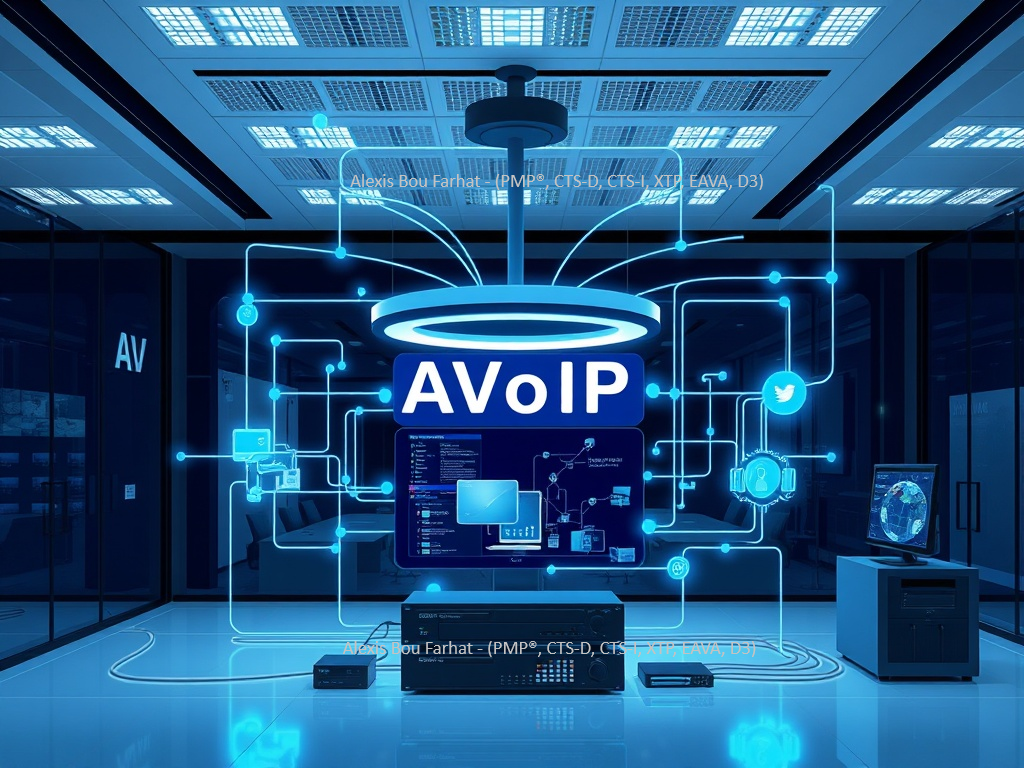LetsTalkAVbyAlexis Series : Episode 2: Network & AV Convergence (AVoIP)

Welcome back to “Let’s Talk AV with Alexis” : where technology meets real-world integration.
In professional AV today, AV over IP (AVoIP) is no longer an emerging trend, it’s the standard approach for scalable, flexible and future-ready systems. But with this shift comes a reality: the network is now the backbone of AV. Unlike traditional matrix switchers and point-to-point cabling, modern AV systems depend heavily on robust network design. A strong network ensures reliable performance, while a weak one leads to latency, dropouts and frustrated end-users.
# Key Design Elements in AVoIP Networks
🔹 VLANs (Virtual Local Area Networks):
Separating AV traffic from corporate or guest traffic reduces congestion, improves security and simplifies troubleshooting. For example, dedicating VLANs to video, audio and control data can prevent bandwidth-heavy streams from interfering with mission-critical IT functions.
🔹 QoS (Quality of Service):
AV traffic—especially real-time video and audio cannot tolerate jitter or packet loss. Implementing QoS ensures that AV packets are prioritized over less urgent traffic such as file transfers or system updates. Without it, even a short network spike can disrupt an entire presentation or meeting.
🔹 Bandwidth Planning:
High-resolution video (4K, 8K), multichannel audio and control signals can easily saturate a poorly designed network. Proper headroom planning, understanding unicast vs multicast behavior and accounting for simultaneous streams is critical. Overlooking bandwidth requirements is one of the most common causes of AVoIP project failure.
🔹 Collaboration Between AV & IT Teams:
The success of AVoIP projects often depends on cross-disciplinary collaboration. AV specialists bring knowledge of latency, codecs and signal flow; IT professionals provide expertise in routing, security and network architecture. Without this collaboration, critical details are missed.
Common Challenges in AV & Network Convergence:
- Multicast Storms: Misconfigured IGMP snooping or queriers can flood a network.
- Security Policies: Corporate IT teams may hesitate to open ports for AV traffic.
- Scalability Issues: Networks designed for current use may fail when demand doubles.
- Training Gaps: AV engineers unfamiliar with IT and IT staff unfamiliar with AV requirements, often leads to communication barriers.
# Discussion Points for AVIXA Xchange Community:
1️⃣ When planning an AVoIP system, what’s the first thing you prioritize—dedicated VLANs, bandwidth, or QoS policies? Why?
2️⃣ Have you faced issues with multicast traffic (e.g., flooding, unstable streams)? How did you solve it?
3️⃣ Do you advocate for a dedicated AV network (isolation, reliability, easier troubleshooting) or a shared corporate backbone (cost savings, centralized management)? Which approach worked best in your experience?
4️⃣ What is the biggest skill gap you see today AV professionals needing stronger IT skills, or IT professionals needing deeper AV knowledge?
5️⃣ Looking ahead, do you see cloud AV (routing signals across WAN/internet) as a threat, an opportunity, or just an extension of current AVoIP practices?
# Key Takeaway:
AV and IT are no longer separate domains. In AVoIP systems, success depends on solid network design, proactive collaboration between AV & IT teams and careful attention to VLANs, QoS and bandwidth planning. The organizations that embrace convergence not resist it will deliver more reliable, scalable and future-proof AV experiences.
-
Xchange Advocates are recognized AV/IT industry thought leaders and influencers. We invite you to connect with them and follow their activity across the community as they offer valuable insights and expertise while advocating for and building awareness of the AV industry.





Please sign in or register for FREE
If you are a registered user on AVIXA Xchange, please sign in